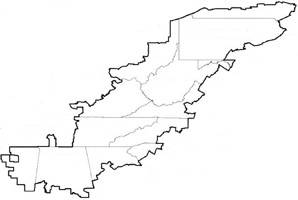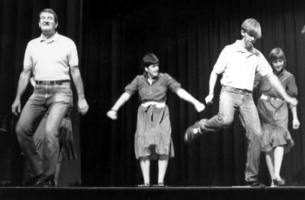
|
The Society of Folk Dance Historians (SFDH)
Buck and Big Circle Dancing
[
Home |
About |
Encyclopedia | CLICK AN IMAGE TO ENLARGE |

|

 For well into the 19th century, long after the birth of our nation, our people still looked to Europe for most of our culture. Fashions, language, music, laws – and dance – were all copied from those of the Old World, Americanized as they may have been, especially among the urbanized East. It would remain for those who moved on into the wilderness of the frontier to begin to create the beginnings of the native Anglo-American culture.
For well into the 19th century, long after the birth of our nation, our people still looked to Europe for most of our culture. Fashions, language, music, laws – and dance – were all copied from those of the Old World, Americanized as they may have been, especially among the urbanized East. It would remain for those who moved on into the wilderness of the frontier to begin to create the beginnings of the native Anglo-American culture.
In New England, the contra dance, taken directly from its roots in England, was the dance of the people. It didn't take long for evolution to begin, as new lyrics were added to old songs, dance figures were given new names, new figures were created, and dance technique was adapted to rough frontier floors and heavy footwear. The dance is still with us and it still remains English in origin.
Further south, in Virginia and the Carolinas, the early settlers had laid claim to most or all of the profitable land, creating the "aristocracy" of the Old South very early on. The isolated valleys of the Great Smoky Mountains and other mountainous areas offered the only hope for those who came after. Mountains do not offer the same rich and tillable soil as do the coastal plains; those who settled there became not only isolated, but usually impoverished. Yet they came: Irish, Welsh, Scots, English and they stayed to pioneer the land and create their own culture, including their music and dance, to which each began to make its own contribution.
The Irish added their beloved step dance to the Scots' set dances, the Welsh and English added figures from their own country-dances. African slaves were not unknown, though not so much as in the plantations, and their presence and contributions enlivened and enriched the staid character of all. Out of this lively mix came what is essentially the first true American dance – the Clog and Big Circle Dance.
The role of the "caller" would have originated here, necessary for the dance to proceed and a tradition that is an integral part of American square dance still. The Big Circle Dance is danced with a curious sliding gate with a slight "chug" backward and a sharp straightening of the knee. The frequency of inserting the clog step varies by region; in the Virginia/Carolina area, the clog is inserted "when the spirit moves you;" many figures are not appropriate to clogging. The more quiet gliding step allows the caller, who dances with the circle, to engage in "patter calls" that add both direction and mirth to the dance.
It is noted that in more southern areas of Georgia and Alabama, the dancers clog almost continuously, resulting in a much louder environment, limiting the caller to short names of figures, such as "Georgia Rang Tang," requiring that everyone knows what Georgia Rang Tang is.
As the name suggests, the dance is done in a circle of couples, eight couples being the ideal size and twelve couples almost the upper practical limit. There should be an even number of couples to accommodate the Small Circle figures. Beginning with the caller, couples are designated as "odd" or "even," but that is not determined until the Small Circle figures begin.
The woman is always on the man's right side. The woman on the man's right side is always his partner no matter who she is. Partners change frequently and that rule must always be followed. The woman on the man's left side is his corner – no matter which woman she is. Obviously, the women's positions are reversed from the men's.
The normal structure of the Big Circle is Big Circle followed by Small Circles followed by a return to the Big Circle. The sequence of calls is left solely to the caller's discretion and imagination.
SOME BIG CIRCLE FIGURES
- Promenade: Couples facing CCW around the circle, woman on man's right with right hands joined above the woman's right shoulder, left hands joined in front of the man.
- Circle Left/Right: Hands joined chest high in a single circle, all moving left or right.
- Half-Sashay: Woman releases right hand hold with corner man; men lead partner across in front of himself to corner lady's position; woman makes a full turn left, facing her partner as she passes in front of him. Everyone now has a new partner and corner.
- Allemande Left the Corner: Facing the corner person, take a left wrist-hold and walk CCW around the corner person until facing the partner.
- Right Hand Around Your Own: Same as "allemande left," except with right wrist-hold and turning CW around partner until facing the corner.
- Do-sa-do Your Partner/Corner: Facing the indicated person, walk CW around that person, passing right shoulders first and return to place passing left shoulders without turning.
- Right Hand High, Left Hand Low, Wring Out the Dishrag, 'Round You Go: From promenade position while still walking forward, man raises joined right hands high forward and lowers joined left hands low forward; at end of call man steps eight steps in place and leads woman forward CCW around him to his right side (woman DOES NOT TURN while walking around man). Man brings both hands close together overhead as woman passes behind. When woman is on man's right side, he leads her into a CCW turn in place by bring joined right hands under the joined left hands and return to the promenade position.
- Ladies to the Center, Circle Left, Gents Go Right: Man leads woman to the center; woman joins hands in women's circle and move left; man joins hands with men and moves right in outside circle. Caller may call, "Other Way Back" to reverse direction.
- Gents to the Left, Arms on Top, Circle Right: Circles stop when men are to their partners' left side; men raise joined hands over woman's heads and women back up slightly to allow men to lower joined hands in front of women. Circle now moves to the right with small walking steps.
- Arms Go Up, Gents Duck Under, Circle Left, Go Like Thunder: Circle stops moving; men raise joined hands over women's' heads and lower behind men to create a "basket." Circle begins to move rapidly CW with a "buzz step."
- Partner/Corner Swing: Face the indicated person, standing right hip to right hip, man's right hand encircling woman under her left shoulder; her left hand rests on man's left shoulder. Both walk forward in a CW spin, turning around a point between them. Clog here as the spirit moves.
- London Bridge: From a promenade, the caller faces his partner, joins his left hand to his partner's right hand. Raising the joined hands in an overhead arch, the lead couple turns and walks against the direction of the promenade, all passing under the arch and in turn making the same arch and following the couple ahead. When the lead couple reaches the end of the line, they follow under the arches to the front of the line again and resume the promenade to reform the Big Circle.
There are contless other figures for the Big Circle. These are only a few.
SOME SMALL CIRCLE FIGURES
- Odd Gent Out to the Right, Circle Up Four: From "Circle Left," the caller releases his left hand and turns with his partner to face the couple to his right; join hands with that couple to create a Small Circle of two couples. This identifies "odd-" and "even-"numbered couples; the next "odd" couple turns right to pick up the next "even" couple. This continues around the circle until all Small Circles are formed; the "odd" couples progress CCW around the circle, while the "even" couples hold the circle. All progressions happen by the "odd" couple moving to the "even" couple with their backs to the center. In the Small Circle, such calls as "Right/Left Hand Star," "Sing Your Corner/Partner" will be followed by "Odd Gent On to the Right" to move the "odd" couple on the next "even" couple. There are many more complicated figures.
- Odd Gent Out to the Left, Big Circle: This figure returns the dance to the Big Circle: From "Circle Up Four," the "odd" gent who has been leading the procession on the inside of the circle, continues turning the Small Circle until he is on the outside of the circle, then he releases his corner's hand and walks forward around the outside of the Big Circle to join hands with the last person in the Small Circle ahead of him and the Big Circle continues as before.
BUCK DANCE
This is the solo "Clog" dance, whether danced by a man or a woman. It is traditional for cloggers to bring their own "clogging board" to dances with them, a square piece of plywood roughly two to three feet on a side with a frame around the bottom to give it some clearance from the floor beneath. The device amplifies the sound of the clog step and dancers' reputations are based on the quality of their clog. Noted women cloggers dance with a delicate and precise style, each beat clear and crisp, feet close to the board. Men, on the other hand, will frequently display a mix of both precise, complex rhythms and powerful, arm-swinging, knee-lifting figures that threaten to destroy the board.
The "old fashioned" clog does not resemble the more modern style with short skirts and jingle taps. It is frequently referred to as "flatfoot clogging" and was danced with heavy work shoes. There are a number of different clogging styles and many cloggers have their own unique style that accents their strengths, personality and creativity. There is probably not a rhythm that has not beem exquisitely rendered on a severely beaten piece of plywood somewhere in the world of flatfoot clogging.
The "mountain people" of Appalachia have given America this, its first American-born dance form, predating Ragtime by decades and generations. The dance was created by the same mix of cultures that created America in the first place, a beautifully combined balance of community cooperation, complex coordination, individual expression – and the joy of life.
SUGGESTED SEQUENCE OF FIGURES
The called figures in the Big Circle dance are at the whim of the caller and must be called in a logical sequence, meaning that each new figure must be "executable" from the previous call. Obviously, there are many options and the caller must make the decision for the new figure soon enough for the call to be made before the current figure is completed. There is no choreographed sequence; the following is a sample sequence only.
These calls are typical of the areas in Virginia and West Virginia. Generally, the Small Circle figures are introduced in the middle of the dance and the Big Circle figures are resumed. These are only a small sample of possible calls. Traditions north and south of there are likely different.
Big Circle Figures
All join hands, circle left
Roll away with a half-sashay; up to the middle and back that way
Swing your Corner; Promenade
The right hand high, the left hand low; wring out the dishrag, 'round you go
Ladies to the center, circle left; gents go right
Reverse
Gents to the left, arms on top, circle right
Arms go up, gents duck under, circle left; go like thunder
Swing your partner; Promenade
Ladies in the lead, Indian style
King's Highway
Queen's Highway
Promenade
All join hands, circle left
Ladies to the center, clog a while
Ladies back out, gents go in
Swing your partner
Promenade
London Bridge
Small Circle Figures
Odd Gent out to the right; circle up four
Left hand star; Right hand star
Odd Gent out to the next; Circle up four
Swing your corner; Swing your own
Odd couple dip for the oyster; Even couple dive for the clam
Odd couple dive under to a four-leaf clover
Even couple do a Buffalo Loop
Odd Gent out to the left; Big Circle, circle left
APPALACHIAN CLOG
The Appalachian Clog derives from the early Irish settlers in the Appalachian Mountains. There was considerable influence from the dance of the African slaves, adding a looseness of the upper body to the dance character. The dance is performed in heavy, low-topped shoes, allowing flexibility in the ankle. The knees should be kept soft with the legs turned out slightly.
NOTE: These are a sample of "old-fashioned" clog figures; there are countless variations.
Women dance with a delicate precision; the men's clog frequently becomes a powerful, thunderous display. The "Buck Dance" is a solo clog, whether danced by men or women. There are numerous regional variations of both the clog technique and terminology of figures. The technique described here was learned from Glenn Bannerman, a famous clogger and teacher from Richmond, Virginia.
Rhythm: Music is in 4/4 meter with a moderate tempo.
Clog Steps
- Shuffle: Quick brush with the ball of the foot forward and backward, low to the floor; supporting leg is straight
- Down: Step in place with a "sinking" flex of the knee
- Scuff: Brush the free heel forward, low
- Chug: Movement forward or backward without leaving the floor; may be on either foot or both feet; forward movement is down; backward movement is up
- Ball-Change: Press down on ball of free foot, lifting body slightly; lift knee quickly forward, dropping weight onto opposite foot with soft knee
Clog Figures
- Short: Shuffle-Down-Ball-Change: "&-a-1-&-2"
- Long: Shuffle-Down (3x)-Ball-Change: "&-a-1, &-a-2, &-a-3, &4
Ball-Change step may be in one place or crossing back and forth across supporting foot. - Chug: Chug forward and back on one foot: "1-&, 2-&, 3-&, 4-&"
Free foot pumps to the side and crosses behind to change weight on count 1 of the next measure. - Step-Scuff-Chug: Step forward on right foot; scuff left heel forward low, snap left knee upward and chug forward on right foot with sharp flex of right knee: "1-&-2"
- Walking Clog: Add shuffle to forward walk
Used primarily in Promenade or when walking in the Big Circle.
DOCUMENTS
- Appalachia, a region,
- Buck and Big Circle Dancing in Appalachia, an article.
- Folk Dancing in the South, an article.
- Richard Duree, an article.
Used with permission of the author.
Printed in Folk Dance Scene, December 2012/January 2013.
This page © 2018 by Ron Houston.
Please do not copy any part of this page without including this copyright notice.
Please do not copy small portions out of context.
Please do not copy large portions without permission from Ron Houston.